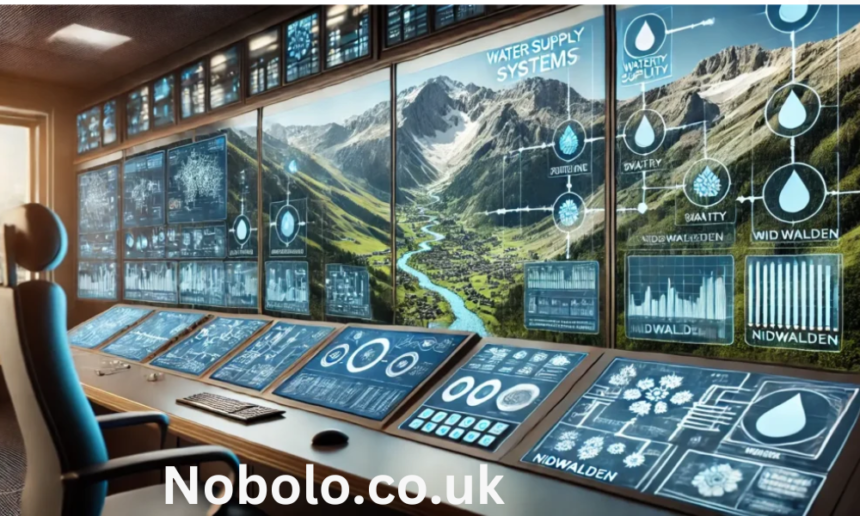Water supply management is an essential aspect of municipal governance, ensuring that residents have access to clean and reliable water. In Switzerland, the canton of Nidwalden is home to various communities (gemeinden), each managing its water resources with utmost care. In recent years, many of these local governments have adopted advanced software solutions to streamline their water supply management, making the process more efficient, transparent, and sustainable.
This article explores the significance of software in managing water supply systems in Nidwaldner Gemeinden, highlighting its benefits, features, and challenges. We will delve into how technology is transforming water management practices and ensuring that communities in Nidwalden can provide uninterrupted services to their residents.
1. Understanding Water Supply Management in Nidwalden
1.1 The Importance of Efficient Water Supply Management
Water is one of the most precious resources for any community. Efficient management of water resources ensures that there is enough water to meet the needs of residents, businesses, and industries. In Switzerland, municipalities are responsible for managing local water supply systems, which involve sourcing, distributing, and treating water for consumption.
Nidwalden, a picturesque canton located in central Switzerland, has several Gemeinden, each with its own unique water supply challenges. The region’s water systems include numerous wells, reservoirs, and pumping stations. Efficient management of these systems is critical for the well-being of the community and the preservation of the environment.
1.2 Challenges in Water Supply Management
Nidwalden’s Gemeinden face a variety of challenges when it comes to water supply management. These include:
- Monitoring Water Quality: Ensuring that the water supply is clean, safe, and meets regulatory standards is a complex task. Contamination from natural or human-made sources can have severe consequences on public health.
- Maintaining Infrastructure: The water distribution system is made up of pipes, pumps, valves, and other infrastructure that requires constant monitoring and maintenance to avoid failures and leaks.
- Resource Management: With growing populations and increasing demand for water, municipalities must carefully manage their water resources to ensure sustainability.
- Compliance with Regulations: Swiss regulations on water quality and conservation are strict, and municipalities must ensure that their water supply systems comply with these rules.
- Cost Management: The operational costs associated with water supply, including energy, maintenance, and labor, can be high. Efficient systems help reduce costs while maintaining quality service.
In response to these challenges, many Nidwalden Gemeinden are turning to innovative software solutions to optimize their water supply systems.
2. The Role of Software in Water Supply Management

2.1 Why Software is Vital for Water Supply Systems
Software solutions have become an indispensable tool for modern water supply management. These systems help municipalities in Nidwalden streamline operations, improve water quality monitoring, and ensure efficient resource use. Here’s how software plays a crucial role in managing water supply systems:
- Real-Time Monitoring: Advanced software platforms provide real-time data on various aspects of the water supply system. This includes monitoring water flow, pressure, and quality, which helps detect issues early on.
- Leak Detection: Water leakage is a significant concern in any water distribution system. Software can identify anomalies in water flow and pressure, allowing municipalities to pinpoint leaks and minimize water loss.
- Asset Management: The infrastructure that supports water distribution—such as pipes, pumps, and reservoirs—requires regular maintenance. Software helps municipalities manage and track these assets, scheduling repairs and replacements as needed.
- Automated Reporting: Compliance with regulations often requires municipalities to submit regular reports on water quality and usage. Software automates this process, ensuring that reports are accurate and timely.
- Predictive Analytics: Using data collected from the water supply system, software can predict potential issues before they arise, allowing for proactive maintenance and reducing the likelihood of system failures.
2.2 Features of Software for Water Supply Management
The software used by Nidwalden Gemeinden for water supply management comes with a range of features designed to optimize efficiency and effectiveness. These features include:
- Data Visualization: Software platforms often come with dashboards that allow municipalities to visualize data related to water supply systems. These visualizations make it easier for decision-makers to understand trends and take action when necessary.
- Mobile Access: Many software solutions are mobile-friendly, allowing field workers to access data on the go. This makes it easier for maintenance teams to respond to issues in the field without having to return to the office.
- Integration with IoT Devices: The Internet of Things (IoT) is increasingly being used in water supply systems. IoT devices, such as smart meters and sensors, collect data that is fed into software platforms for analysis and decision-making.
- Cloud-Based Solutions: Cloud-based software allows municipalities to store data securely and access it from anywhere. This flexibility is particularly useful for coordinating between different departments and teams.
- Cost Tracking and Analysis: Water supply management involves significant costs. Software can track these costs, analyze consumption patterns, and help municipalities optimize spending.
2.3 Case Studies: Successful Implementation of Software in Nidwalden
Several Gemeinden in Nidwalden have successfully implemented software solutions to improve their water supply systems. Here are a few examples:
2.3.1 Stans
The Gemeinde of Stans, the capital of Nidwalden, adopted a comprehensive water supply management system that integrates real-time monitoring and predictive analytics. This system helps detect leaks, monitor water quality, and ensure the efficiency of pumping stations. The result has been a reduction in water loss by over 15%, leading to significant savings in operational costs.
2.3.2 Wolfenschiessen
Wolfenschiessen, a rural Gemeinde in Nidwalden, implemented an asset management system to track the condition of its water infrastructure. The system helps identify when maintenance is required and has extended the lifespan of the community’s water pipes by several years. It also allows for better planning of capital investments.
2.3.3 Hergiswil
Hergiswil, a lakeside Gemeinde, faced challenges with water quality due to seasonal fluctuations in the lake’s water level. To address this, the community implemented a software solution that continuously monitors water quality and provides alerts when contamination is detected. This system has improved the community’s response time to potential water quality issues.
Also Read: Alyson Heather Belcourt
3. Benefits of Using Software in Water Supply Management
3.1 Improved Efficiency
One of the primary benefits of using software for water supply management is increased operational efficiency. Real-time monitoring and automated systems reduce the need for manual data entry and streamline decision-making. This allows municipalities to allocate resources more effectively and ensure that the water supply system is running smoothly.
3.2 Enhanced Water Conservation
Software solutions help municipalities monitor water usage patterns and identify areas where conservation efforts can be improved. By optimizing water distribution and detecting leaks early, software contributes to more sustainable water use, which is essential in a world facing increasing water scarcity.
3.3 Cost Savings
Efficient water supply systems lead to significant cost savings. By automating routine tasks, detecting issues early, and optimizing resource use, municipalities can reduce their operational costs. Additionally, predictive analytics help plan for long-term investments, ensuring that resources are allocated wisely.
3.4 Increased Transparency and Accountability
Software platforms provide detailed reports and data visualizations, which can be shared with the public. This increases transparency and accountability, allowing residents to see how water resources are being managed. Public trust is crucial in water supply management, and software helps foster this trust by ensuring that the system is operating efficiently and sustainably.
3.5 Regulatory Compliance
In Switzerland, water supply systems are subject to strict regulatory standards. Software helps municipalities comply with these regulations by automating the process of data collection, reporting, and analysis. This ensures that communities are meeting their legal obligations while also protecting the environment.
4. Challenges of Implementing Software in Water Supply Management
4.1 High Initial Investment
The initial cost of implementing software solutions can be high. For smaller Gemeinden, this can be a barrier to adoption. However, the long-term benefits of increased efficiency and cost savings often outweigh the initial investment.
4.2 Training and Adaptation
Staff members need to be trained to use the new software, which can take time and resources. Ensuring that employees are comfortable with the system is crucial for its successful implementation.
4.3 Data Security
With the increasing reliance on digital platforms, data security becomes a significant concern. Municipalities must ensure that their software systems are secure to protect sensitive data, including information on water quality and infrastructure.
4.4 Integration with Legacy Systems
Many Gemeinden in Nidwalden have existing water supply management systems that may not be compatible with modern software. Integrating new software with legacy systems can be a complex and time-consuming process.
5. The Future of Water Supply Management in Nidwalden
5.1 The Rise of Smart Water Networks
The future of water supply management in Nidwalden lies in the development of smart water networks. These networks will leverage advanced technologies such as IoT, artificial intelligence, and machine learning to create more responsive and efficient systems. With smart sensors and real-time data analysis, municipalities will be able to predict and prevent issues before they occur, further optimizing water distribution.
5.2 Sustainable Practices
As the world faces environmental challenges, municipalities in Nidwalden will continue to focus on sustainability in their water supply management. Software will play a crucial role in promoting water conservation, reducing energy consumption, and ensuring the responsible use of water resources.
5.3 Integration with Renewable Energy
Water supply systems are energy-intensive, and integrating renewable energy sources such as solar and wind power into these systems will become increasingly important. Software will help municipalities manage energy usage and integrate renewable energy efficiently into their water supply systems.
Conclusion
The role of software in water supply management is transforming the way Gemeinden in Nidwalden approach water distribution. From real-time monitoring to predictive analytics, software solutions are helping municipalities improve efficiency, reduce costs, and ensure the sustainability of water resources. While there are challenges to overcome, the benefits of software in managing water supply systems are undeniable. As technology continues to evolve, the future of water supply management in Nidwalden will be more efficient, transparent, and sustainable than ever before.
By embracing advanced software solutions, Nidwalden’s Gemeinden are setting a new standard for water management, ensuring that residents have access to clean, safe, and reliable water for generations to come.



